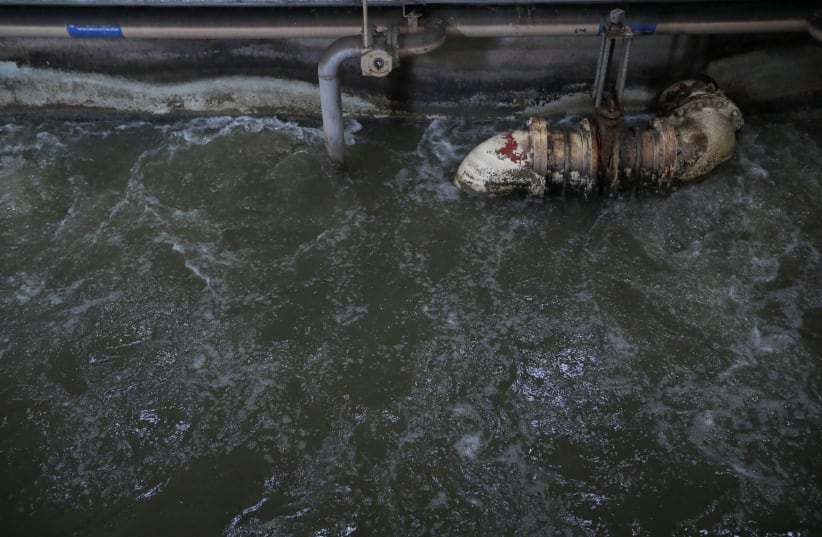How testing wastewater could help you predict viruses in the future
How the introduction of comprehensive wastewater surveillance could become a part of our normal public health infrastructure.
During the COVID-19 pandemic, the Health Ministry in Jerusalem sent inspectors to take samples of sewage in some places to determine whether the virus had spread to certain localities, but it didn’t cover all locations and was not ongoing.
In the not-so-distant future, however, people in various parts of the world could be able to tune in to their favorite news source for an update on their community health status, just as they check on the local weather forecast.
The community health status is similar to the color-coded Doppler weather data that provides meteorologists with information about rain, snow or hail, its motion and intensity that they use to check specific areas where dangerous weather conditions exist. Having this information has proven to be a valuable tool to protect life and property.
“The new community health report we have developed shows and analyzes for the first time the human virome – all the known human viruses – that are circulating in the community, by regularly and comprehensively scrutinizing public wastewater,” said microbiology Prof. Anthony Maresso at the Baylor College of Medicine in Houston, Texas. “Knowing the up-and-down patterns within the viral landscape of human wastewater, the changes in the relative proportions of the different viruses in time and by location, is increasingly proving to be a powerful tool to improve our understanding of outbreaks, transmission and the effects on overall population health,” he said,
Just like people periodically visit their physician to conduct a wellness exam that could detect important health changes such as early onset of diseases, community wastewater surveillance assesses the health of the community by analyzing changes in the human virome that could point at potential emerging diseases. Texas is the first in the US to develop and implement a complete pipeline to conduct wastewater surveillance on the human virome from sample collection, analysis and interpretation to producing periodical reports on the health of communities that are sent to public health officials.
“This is the work of the newly formed Texas Wastewater Consortium. To our knowledge, it’s the first working group to push for the introduction of comprehensive wastewater surveillance as part of our normal public health infrastructure,” Maresso said.
In their ground-breaking study published in the journal Nature Communications under the title “Wastewater sequencing reveals community and variant dynamics of the collective human virome,” Maresso and his colleagues showed that they can detect changes in viral trends in wastewater weeks before they are detected in the clinic. “Think of it as a very fancy smoke alarm that brings to the attention of scientists, physicians and public health authorities the progressively increasing proportions of a particular virus strain in the community, one they need to follow closely, assessing its outbreak potential,” said first author Assistant Prof. Michael Tisza. “For instance, we knew about monkeypox well before most clinical settings knew about it because we detected it in wastewater.”
The researchers believe that this valuable technology is going to be one way they can get ahead of not only all known viruses that can be shed in wastewater, but also to potentially get an upper hand on what is brewing – the next virus that we don’t yet know about.
“Had we had this in place during the time COVID-19 was emerging, we may have seen some coronavirus sequences that alerted us of the new sequence of the COVID-19 virus that began spreading in 2019 and exploded into a pandemic,” Maresso said.
Polio was the first virus to be monitored in wastewater. In the early 1940s, Yale University scientists showed that poliovirus, which had been previously shown to be present in stool samples from infected people, could be detected in wastewater.
“SARS-CoV-2, the virus that causes COVID-19, is shed in human stools and in urine at very high levels,” Maresso said. “This finding revived the idea of analyzing wastewater to monitor the levels of the virus as a reliable indicator of community outbreaks. His team had used very laborious methods to detect the polio virus that offered little sensitivity, but now we have highly sensitive technologies that analyze viral genetic materials such as PCR and genetic sequencing.” This was a breakthrough, because clinical testing such as the analysis of nasal swabs has a lag time before the results are available, sometimes a week.
“Also, as the pandemic progressed, people tired of testing, so scientists, physicians and public health officials did not have accurate information of the community viral load,” Maresso said. “On the other hand, analyzing wastewater, because everybody contributes to that, is a good, independent, unbiased way of monitoring community load of the virus.”
In the journal paper, they described how they developed and implemented a community health report for the cities of Houston and El Paso. The goal is for the program to be statewide. Before this work, only a few viruses were ever detected in wastewater. It was three different tests for three different viruses. Our method is one-test-for-all 3,153 different viruses in the panel, as well as possibly new mutations in these viruses. Basically, we search for all the virome that is possible.”
This approach enabled them to identify more than 450 distinct disease-causing viruses from 28 viral families, most of which have never been detected in such samples. Sequencing reads of established pathogens and emerging viruses correlate to clinical data sets of SARS-CoV-2, influenza virus and monkeypox outlining the public health utility of this approach. “We may be able to tell people, for example, that flu season is a few weeks early this year, so you should get your shot early,” Maresso concluded.


No comments:
Post a Comment
Stick to the subject, NO religion, or Party politics